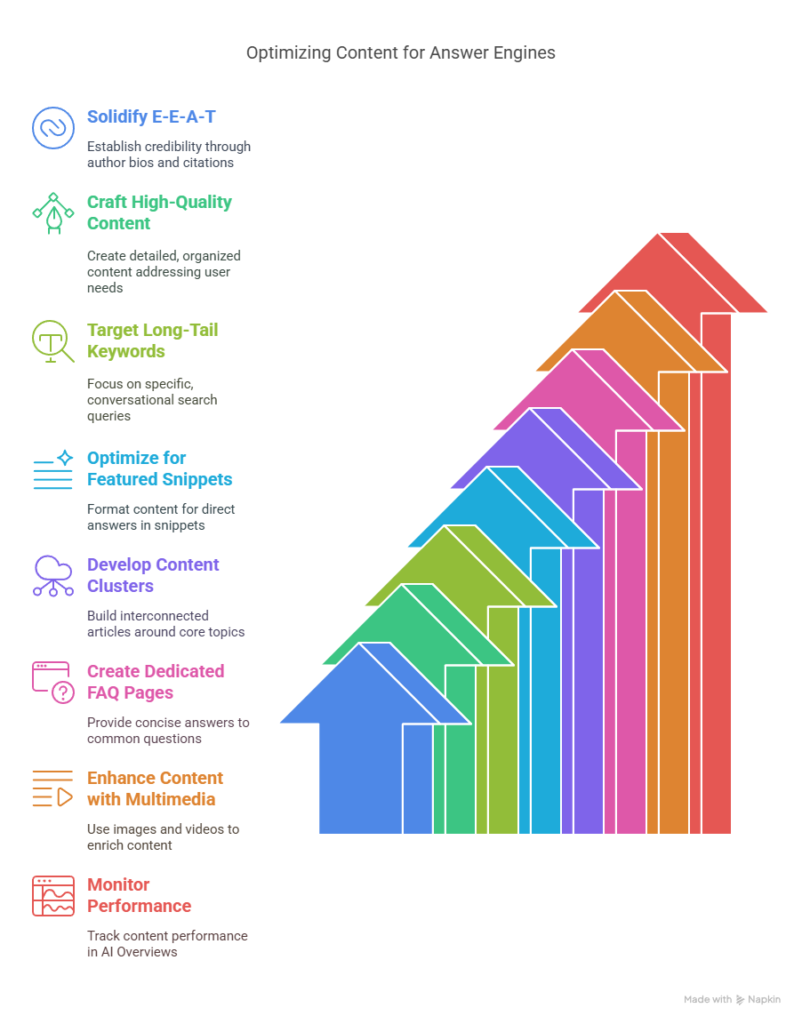The world of Search Engine Optimisation (SEO) is in constant flux, but the recent rise of Artificial Intelligence (AI) is ushering in changes of a truly fundamental nature. If you’re looking to ensure your online presence thrives not just today but also tomorrow, understanding and adapting to these shifts is paramount.
This isn’t just about chasing rankings anymore. We’re entering an era where search engines, powered by sophisticated AI, are increasingly focused on providing direct, immediate answers to user queries right on the search results page. This has led to the emergence of concepts like AI Overviews and what we’ll call Answer Engine Optimisation (AEO) – which our source material refers to as AIO.
This comprehensive guide will walk you through the intricacies of this evolving landscape and provide a step-by-step method to optimise your content for the age of AI-powered search.
Understanding the AI Revolution in Search
Before diving into the “how-to,” let’s establish a clear understanding of the key players in this transformation.
What are AI Overviews?
AI Overviews are AI-generated summaries that appear at the very top of search engine results pages (SERPs). Their primary purpose is to offer users quick, concise, and effective answers to their queries without requiring them to click through multiple websites. Think of it as getting the core information you need instantly.
This process is typically powered by advanced AI models, such as Google’s Gemini, which scour the internet for relevant information. This information is then aggregated, synthesised, and presented as a direct answer.
The generation of AI Overviews generally follows these steps:
- Understanding the Search Query: The search engine employs Natural Language Processing (NLP) to decipher the user’s search terms and underlying intent.
- Content Aggregation: The AI model then examines all the indexed web pages to identify information relevant to the search query. Only trusted and indexed sources are considered.
- Summarisation: Using generative AI, the model creates a coherent and easily understandable summary of the gathered information.
- Display: Finally, the AI Overview is displayed prominently at the top of the SERP, often accompanied by links to the sources from which the information was drawn.

For example, if a user searches for “best practices for email marketing,” an AI Overview might present a bulleted list of key recommendations with brief explanations, followed by links to authoritative sources.
Read Also : Are AI Tools Weakening Coding Skills?
What is Answer Engine Optimisation (AEO)?
Answer Engine Optimisation (AEO), or AIO as referred to in our source, is the process of optimising your content specifically to appear in these AI-generated direct answers. This goes beyond traditional SEO, which primarily focuses on ranking your website as a link in the search results.
AEO aims to make your content the source that AI models rely on when generating their overviews and direct answers. This includes optimising not just for AI Overviews but also for other AI-powered features like voice search results and chatbot responses.
The core difference from traditional SEO lies in the objective. While traditional SEO aims to drive traffic to your website by ranking high for relevant keywords, AEO focuses on providing the best possible answer to a user’s query in a format that AI can easily understand and utilise.
The Shifting Sands: How AI Impacts Traditional SEO
The rise of AI in search is not just a minor tweak; it’s a significant reshaping of the SEO landscape. Understanding these impacts is crucial for adapting your strategy.
- Increased Competition for Visibility: With AI Overviews providing immediate answers, users may not need to click on organic search results, leading to a potential decrease in organic traffic, especially for informational content.
- The Primacy of User Intent: AI-powered search prioritises understanding what the user truly wants to know. This means SEO professionals need to shift their focus from simply targeting high-volume keywords to creating content that directly addresses specific questions and solves particular problems.
- The Rise of Zero-Click Searches: A significant portion of searches now result in the user finding their answer directly on the SERP without clicking on any links. Studies suggest that a substantial percentage of searches on platforms like Bing and Google are now zero-click. This necessitates a re-evaluation of traditional SEO metrics like Click-Through Rate (CTR).
- Challenges for Content Creators: AI Overviews often aggregate information from multiple sources without always providing prominent credit to each individual creator. This can be particularly challenging for smaller websites and content creators striving to gain visibility.

A Step-by-Step Guide to Optimising for AEO (AIO)
While these changes present challenges, they also offer significant opportunities for those who adapt proactively. Here’s a step-by-step approach to optimise your content for the age of Answer Engines:
Step 1: Solidify Your E-E-A-T (Experience, Expertise, Authoritativeness, Trustworthiness)
Search engines, even before the rise of widespread AI, favoured content that demonstrated these qualities. In the age of AI, this becomes even more critical as AI models are trained to identify and prioritise reliable and trustworthy sources.
- Actionable Advice:
- Include a detailed author bio for every piece of content, highlighting their expertise and experience. Place it prominently, either at the beginning or end of the article.
- Meticulously cite all sources used in your content in a dedicated “Sources” section. Ensure these sources are reputable and well-recognised.
- Incorporate case studies, statistics, and data from trustworthy and authoritative sources.
- Regularly update your existing content to ensure its accuracy and relevance.
Step 2: Craft High-Quality, Detailed, and Well-Organised Content
AI Overviews favour in-depth content that comprehensively answers user queries. Well-structured content is also easier for AI to understand and summarise.
- Actionable Advice:
- Use clear and descriptive headings (H1, H2, H3, etc.) and subheadings to organise your content logically.
- Break down complex information into bullet points and numbered lists for improved readability and easier processing by AI.
- Directly address the questions and pain points of your target audience with accuracy and detail.
- Aim to provide the best and most complete answer available on the topic. Look at existing top-ranking content and strive to create something even better.
Step 3: Target Long-Tail and Conversational Keywords
With the rise of voice search and more natural language queries, users are interacting with search engines in a more conversational manner.
- Actionable Advice:
- Identify and target long-tail keywords – longer, more specific phrases that reflect how people actually ask questions (e.g., instead of “SEO tips,” target “how to improve SEO for AI overviews in 2025”).
- Optimise for conversational queries that resemble natural language questions (e.g., “what do you think of iPhone 6?”).
- Utilise SEO tools like Semrush or Ahrefs to identify relevant long-tail and question-based keywords.
Step 4: Optimise for Featured Snippets
AI Overviews sometimes draw information from featured snippets. Optimising for featured snippets can increase your chances of appearing in AI-generated answers.
- Actionable Advice:
- Structure your content to directly answer specific questions concisely and clearly.
- Include a dedicated section, potentially at the end of your article, that answers frequently asked questions (FAQs) related to the topic in a brief yet informative manner.
- Use question-and-answer formats within your content.
- Employ schema markup to help search engines understand the structure and meaning of your content, including FAQ schema.
Step 5: Develop Content Clusters
Creating a network of interconnected articles around a central topic can establish you as a subject matter expert in the eyes of search engines.
- Actionable Advice:
- Identify core topics relevant to your niche.
- Create multiple articles that delve into various aspects of these core topics.
- Interlink these related articles to create a content cluster or topic hub. This helps search engines understand the relationships between your content and recognise your expertise.
Step 6: Create Dedicated FAQ Pages
Having dedicated FAQ pages can provide concise answers to common questions and improve your visibility in direct answer formats.
- Actionable Advice:
- Create separate pages dedicated to answering frequently asked questions related to key areas of your website’s content.
- Provide brief and direct answers on these FAQ pages.
- Link these FAQ answers back to more detailed articles on your website for users who need more information.
Step 7: Enhance Content with Multimedia
Incorporating various forms of media can enhance the value and engagement of your content, making it more appealing to both users and AI.
- Actionable Advice:
- Include relevant images, videos, infographics, and other multimedia elements to complement and explain your text. This can help illustrate complex concepts and cater to different learning styles.
Step 8: Monitor Your Performance in AI Overviews
Keep track of how your content is performing in the new AI-powered search landscape.
- Actionable Advice:
- Utilise analytics tools that provide insights into your content’s appearance in AI Overviews. Most modern SEO analysis tools are now offering this functionality.
- Monitor keyword performance and identify opportunities to further optimise for direct answers.

Focus on the Human User First
While optimising for AI is crucial, remember that your primary audience is still human beings.
- Actionable Advice:
- Write in a natural and conversational tone as if you were explaining the topic to a friend. Avoid overly technical jargon where possible.
- Focus on providing clear, concise, and helpful information that truly addresses the user’s needs.
- Avoid keyword stuffing or creating unnatural-sounding content solely for the sake of AI. High-quality, user-centric content will naturally align with what AI aims to surface.
The Future is Now: Embracing AEO (AIO)
The emergence of AI Overviews and the necessity of Answer Engine Optimisation are not fleeting trends; they represent a fundamental shift in how people find information online. While this may present challenges for traditional SEO approaches, it also offers a significant opportunity for websites of all sizes to gain visibility by focusing on providing the best answers.
Don’t get discouraged by pessimistic voices claiming the demise of SEO. Instead, embrace this evolution, adapt your strategies, and focus on creating valuable, informative content that directly addresses user intent. By following a step-by-step approach to AEO (AIO), you can position your online presence for success in the evolving AI-powered search landscape.
FAQs
1. What are AI Overviews?
AI Overviews are AI-generated summaries that appear at the top of search engine results pages (SERPs). They aim to provide users with quick, concise answers to their queries without requiring them to click through multiple websites. These summaries are created by advanced AI models like Google’s Gemini, which aggregate and synthesize information from trusted sources.
2. How do AI Overviews impact traditional SEO?
AI Overviews have significantly reshaped traditional SEO by:
- Increasing competition for visibility, as users may not need to click on organic results.
- Prioritizing user intent over keyword volume.
- Contributing to the rise of zero-click searches, where users find answers directly on the SERP.
- Challenging smaller websites to gain visibility, as AI often aggregates information from multiple sources.
3. What is Answer Engine Optimization (AEO)?
Answer Engine Optimization (AEO), also referred to as AIO, is the process of optimizing your content to appear in AI-generated direct answers, such as AI Overviews, voice search results, and chatbot responses. Unlike traditional SEO, which focuses on driving traffic through rankings, AEO ensures your content is used as a source for AI-generated answers.
4. How can I optimize my content for AI Overviews?
To optimize your content for AI Overviews:
- Solidify your E-E-A-T (Experience, Expertise, Authoritativeness, Trustworthiness).
- Craft high-quality, detailed, and well-organized content.
- Target long-tail and conversational keywords.
- Optimize for featured snippets using schema markup.
- Develop content clusters and create dedicated FAQ pages.
- Enhance your content with multimedia elements like images, videos, and infographics.
5. What is the difference between traditional SEO and AEO?
The main differences between traditional SEO and AEO are:
- Objective: Traditional SEO aims to rank your website high in search results, while AEO focuses on providing the best possible answer to user queries in a format AI can easily understand and use.
- Traffic Source: Traditional SEO drives traffic through clicks, whereas AEO prioritizes visibility in AI-generated summaries, even if it doesn’t lead to clicks.
- Content Format: AEO emphasizes concise, structured, and authoritative content tailored for AI processing.
6. Why is targeting long-tail and conversational keywords important for AEO?
Targeting long-tail and conversational keywords is crucial because:
- Users interact with search engines more conversationally, especially with voice search.
- Long-tail keywords reflect how people naturally ask questions (e.g., “how to improve SEO for AI overviews in 2025”).
- Optimizing for these keywords increases your chances of appearing in AI Overviews and voice search results.
7. What tools can help me implement AEO strategies?
Some useful tools for implementing AEO strategies include:
- Keyword Research: Semrush, Ahrefs, Google Keyword Planner
- Performance Tracking: Google Search Console, SEMrush Analytics
- Schema Markup Generator: Schema.org, Yoast SEO Plugin
- Content Optimization: Grammarly, Hemingway App, SurferSEO
8. What is E-E-A-T, and why is it important for AEO?
E-E-A-T stands for Experience, Expertise, Authoritativeness, and Trustworthiness . It’s a framework used by search engines to evaluate content quality. In the age of AI-powered search, E-E-A-T is critical because AI models prioritize reliable and trustworthy sources when generating answers. To improve E-E-A-T:
- Include detailed author bios highlighting expertise.
- Cite reputable sources in a dedicated “Sources” section.
- Regularly update content to ensure accuracy.
9. How can I monitor my performance in AI Overviews?
You can monitor your performance in AI Overviews by:
- Using analytics tools like Google Search Console or SEMrush, which now offer insights into AI Overview appearances.
- Tracking keyword performance and identifying opportunities to optimize for direct answers.
- Observing changes in organic traffic and engagement metrics.
10. Is traditional SEO still relevant in the age of AI-powered search?
Yes, traditional SEO remains relevant but has evolved. While AI-powered search prioritizes direct answers, traditional SEO principles like keyword research, content quality, and technical optimization are still foundational. The key is to adapt your strategy to focus on both human users and AI algorithms.
11. How can small websites compete in the era of AI Overviews?
Small websites can compete by:
- Focusing on niche topics where they can establish authority.
- Creating highly detailed and unique content that addresses specific user queries.
- Optimizing for featured snippets and long-tail keywords.
- Building content clusters to demonstrate expertise in a particular area.
- Leveraging multimedia and interactive elements to enhance engagement.
12. What are the future trends in AI-powered SEO?
Future trends in AI-powered SEO include:
- Greater reliance on generative AI for content creation and summarization.
- Enhanced personalization in search results based on user behavior.
- Increased importance of voice search and conversational queries.
- Continued growth of zero-click searches and AI-generated answers.
Read Also : Mastering Google Whisk Seed : A Comprehensive Guide to AI-Powered Image Remixing





